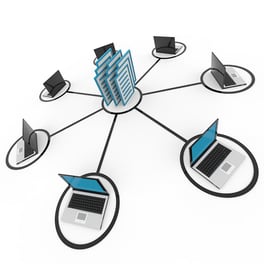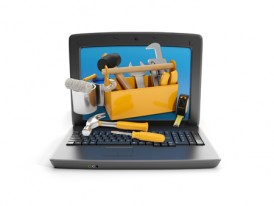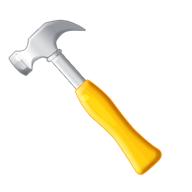1 min read
What Does the Future of Manufacturing Software Look Like Now?
Dassault Systemes recently announced the purchase of Apriso, apparently to acquire the manufacturing market in India… so what does that mean for...
5 min read
David Oeters : October 31, 2013 at 9:51 AM
 Selecting a paperless manufacturing or MES (Manufacturing Execution System) software solution is a critically important investment for manufacturers, delivering shop floor visibility and control with a proven return on investment. Hardware is also an important piece of the solution. The goal of IT and the implementation team is to select hardware that will maximize value, prevent software obsolescence and create an easy to support infrastructure for IT staff.
Selecting a paperless manufacturing or MES (Manufacturing Execution System) software solution is a critically important investment for manufacturers, delivering shop floor visibility and control with a proven return on investment. Hardware is also an important piece of the solution. The goal of IT and the implementation team is to select hardware that will maximize value, prevent software obsolescence and create an easy to support infrastructure for IT staff.
We’ll consider hardware options on the market today, and what is fueling the hardware revolution. We’ll take a closer look at the shop floor and how conditions there should influence your decision. Finally, we’ll consider how the software and hardware should be matched to ensure a sustainable, adaptable solution that won’t slowly degrade to a legacy system hindering operations and using excessive IT support.
Integrated circuit manufacturing technology, which places a number of hardware tools in a smaller space, is offering the shop floor a dizzying array of options. Complex circuits were previously built using subcomponents. Today the same functions can be achieved with Integrated Chip’s (IC’s) powering inexpensive hardware such as smart phones, tablets and computing platforms.
For a little perspective, consider the Broadcom BCM2835 chip, which acts as a CPU and contains:
An ARM CPU;
Multimedia co-processor;
Hardware video encoding/decoding;
High speed bus for transporting high definition images and video;
Fast/efficient OpenGL graphics rendering engine;
Outputs for connecting LCD and HDMI high definition displays.
With so much capability available on one chip, complex systems can be created in a number of formats, not just the desktop or laptop system previously required to run software on the shop floor. IC’s reduce cost, simplify maintenance, and open up a wide range of applications.
 Hardware should be scaled to the software and the shop floor needs. It should run anywhere on your shop floor, and offer easy upgrades if needed. Consider the following shop floor options:
Hardware should be scaled to the software and the shop floor needs. It should run anywhere on your shop floor, and offer easy upgrades if needed. Consider the following shop floor options:
Desktop. With a number of configurations and raw computational power, the desktop is a powerful tool, but an expensive one. Many desktops are overpowered, general-purpose shop floor solutions with more capability than necessary.
Mini-Desktops. These are a smaller, lower-priced hardware option. Intel’s Next Unit of Computing (NUC) is an example of a mini-desktop. By using the latest advances in IC’s, mini desktop systems reduce the cost, heat and power, while maintaining the flexibility of a general purpose system.
Thin Clients. These systems are the traditional alternative to the desktop system. The typical thin client has just enough hardware to boot itself and connect to a central server. Thin clients have a lower upfront hardware cost, but can be a challenge to configure and incur a higher maintenance/admin costs. They aren’t suited to all functions (including bandwidth-intensive videos).
Computing Platform. Another tool using Integrated Chips and based on the lean client hardware, computing platforms such as Raspberry Pi offer proven, full-featured desktop software (such as Linux) in a small package. They can often meet the specialized needs of the shop floor with little trouble.
Tablets. For operations that require maximum mobility, there is no better tool than a tablet. In the past, tablets required specialized software (apps) to make the best use of the limited screen size. Currently tablets are equipped with a simple browser - delivering mobility through web applications, and in a wide range of screen sizes.
Technology should augment, improve and optimize shop floor operations. Consider hardware as a tool for improving efficiency and getting specific jobs done.
No matter the MES (Manufacturing Execution System) or paperless manufacturing software you’ve selected, you need a way to view the system on the shop floor. Conditions there will influence your hardware decisions, such as:
 Space. You need room for your hardware, and the solution must scale to the space you have available. Many shop floors have little room to spare. A desktop system and screen will take up space, while a tablet using a browser-based system will take up almost no space.
Space. You need room for your hardware, and the solution must scale to the space you have available. Many shop floors have little room to spare. A desktop system and screen will take up space, while a tablet using a browser-based system will take up almost no space.
Environment. Shop floors are known for a wide variety of environmental hazards. Clogged fans and heat sinks on desktop or laptop systems occur on shop floors with a high particulate count.
Power consumption. Running hardware will take power. Selecting a system that uses more electricity will not only increase the cost and require more power; it will generate additional heat and increase HVAC costs.
Cost. Hardware is an investment. Select hardware that meets system needs without wasting capability. If you don’t need certain features, there is no reason for the additional investment.
Mobility. Manufacturing mobility is a hot topic now. Mobile hardware will allow your shop floor to work off the grid, and ensure work instructions get to where they are needed most. But, hardware offering mobility may have a smaller screen, limiting the shop floor viewing.
Many times, major investment projects focus solely on the present, and end up sacrificing the long-term viability of the project. For example, a paperless manufacturing system might meet current needs at the time requirements were written, but within a month those requirements will change as new regulations or new technology is introduced, or the customer has a new requirement or needs a new process.
That’s why it is critically important to look at the adaptability of any software or hardware purchases. Software should run on almost any hardware system with minimal customization. If necessary, can new features or functionality be added later at a low cost? Can the hardware be moved once it is installed? Can memory or computing power be added? Will there be a disconnect between hardware and software if there is an upgrade?
Simply put – software becomes a legacy system if it can’t be easily enhanced, changed, upgraded or tested. Will you be installing a legacy system?
The only constant on the shop floor is change, and your technology systems need to account for change. In our experience, browser-based software systems offer the most adaptability at the lowest cost in time and trouble, and can be run on most hardware systems. This is not to say all solutions must be browser-based, but it makes a good starting place when planning an installation. Shop floor needs and hazards will greatly influence hardware selection, but ensure your final selection will grow as the software evolves.
 Advances in integrated circuit design, software and cloud technology, and manufacturing over the last ten years have fueled a wealth of new options for the savvy shop floor. The industry shows no signs of slowing down. In fact, Intel and Arduino recently made announcements of new products, which appear to be aimed at offering powerful, functional hardware options.
Advances in integrated circuit design, software and cloud technology, and manufacturing over the last ten years have fueled a wealth of new options for the savvy shop floor. The industry shows no signs of slowing down. In fact, Intel and Arduino recently made announcements of new products, which appear to be aimed at offering powerful, functional hardware options.
The Intel Galileo is a new microcontroller based on Intel’s new Quark platform – using a 400 MHz Pentium-based processor at its core. It fills a major vacancy in Intel’s product line. Intel’s Core architecture fulfills the need for processor intensive applications like laptops and their Atom architecture for mid-level applications like net books, but there was previously no solution for small embedded systems. Intel has some catching up to do in the embedded systems market, but they appear to be on the right track. One interesting note about the new Galileo microprocessor board is that it’s designed to be fully compatible with the large number of existing Arduino “shields” (add-on boards).
In addition to Intel’s new offering, Arduino also has a new microprocessor in the works, The Arduino TRE. The TRE is built around a Texas Instruments 1GHz Sitara AM335x processor. One unique aspect of the TRE is that it also includes an Arduino board built in, allowing it to be backwards compatible with the highly successful existing Arduino board and related accessories while also providing a serious upgrade in processing power.
It’s an exciting time to be in IT, and never has the market offered more options. The most important factor in choosing a solution is to balance the hardware and software selection. A compromise in either can lead to a loss of efficiency, flexibility and profitability. Keep an eye here as we continue to cover the issues affecting you and the shop floor!
1 min read
Dassault Systemes recently announced the purchase of Apriso, apparently to acquire the manufacturing market in India… so what does that mean for...

1 min read
For manufacturers searching for an Off-the-Shelf (OTS) software solution for the shop floor, but the truth is, you may be surprised what OTS for...

1 min read
Most manufacturers know quality and efficiency would suffer if they asked their shop floor to use the wrong tool, but all too often that’s what...